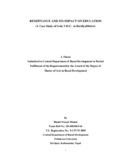Please use this identifier to cite or link to this item:
https://elibrary.tucl.edu.np/handle/123456789/2195| Title: | Remittance and Its Impact on Education (A Case Study of Gola V.D.C. In Bardiya district) |
| Authors: | Dhakal, Bhakti Prasad |
| Keywords: | Remittance;Education;Gola V.D.C., Bardiya Distrct |
| Issue Date: | Jun-2013 |
| Publisher: | Central Department of Rural Development Tribhuvan University Kirtipur, Kathmandu, Nepal |
| Abstract: | Remittance is generally defined as workers compensation income or money either in cash or cheque or kind of send from the international labor market to the home (migrant sending country). This is fact that remittance has larger benefit to the receiving country in aggregate level as well as in household level. The volume of remittance in flow in study areas is increasing day by day and season by season. Nepal is a land locked country, agricultural and developing country and is suffering from the problem of unemployment and underemployment. Due to the lack of employment opportunities in country skilled unskilled and semi skilled all types of people have shown interest to the foreign employment. Most of remittance income is used in the unproductive fields like land purchasing, house purchasing, luxurious goods and consumption etc. The study tries to highlight the use of remittance income on education of person employed community in Gola VDC,Bardiya district. The present research aims to analyze the economic impact of foreign employment and inward remittance entering inside the country for this purpose, review of related literature in this concerned area is must which will help me to get clear ideas, opinions and other concept. Therefore, in this chapter conceptual framework given by different author and intellectuals of this area, books, journals, research work and previous thesis related to labor migration inward remittance are reviewed. This is micro study, due to which it may not be generalized at macro level. Research design is slightly descriptive as well as analytical. The primary data was collected with the help of tools and techniques. The secondary data was used from various publication published by different GOs and NGOS institutions or agencies. In this study, out of 200 migrant people's household in study area having different cast and ethnic groups. Only 50 HH (25 percent) have been taken sampled (22 are male and 28 female) households heads were respondents either they were male or female. Simple mathematical methods; like average, percentage figures, charts and tables are used in relevant places to the main topic into sub-heading according to the nature of data have been chosen according to the finding. This study concluded that the use of remittance on consumption and education is increasing positively. Remittance inflows and its current situation in the study area are high. But micro level, study shows that 6 remittances are spent primarily on consumption of goods, purchasing land, house, expenditure on education and services level is being increasing as the remittance income increases. Due to the lack of job opportunity in the country, most of people are migrated forforeign employment. Job not found in country. To decrease family loan, to earn high amount of money are the major causes for migrant. The study shows that unofficial channels are often used to remit their foreign remittance. The tendency of going abroad is increasing day by day. Thus, it is not minded in appropriate time, the present tendency of use remittance will certainly bring shocks for national economy. More expenditure on land purchasing, social ceremony should control in such a way that they use only domestic production, investment on education and it can help to preserve foreign currency. |
| URI: | http://elibrary.tucl.edu.np/handle/123456789/2195 |
| Appears in Collections: | Rural Development |
Files in This Item:
| File | Description | Size | Format | |
|---|---|---|---|---|
| Bahkti Prasad Thesis 10007.pdf | 341.73 kB | Adobe PDF |  View/Open |
Items in DSpace are protected by copyright, with all rights reserved, unless otherwise indicated.
